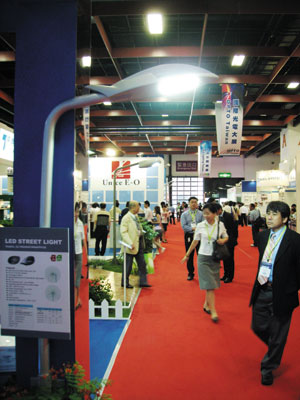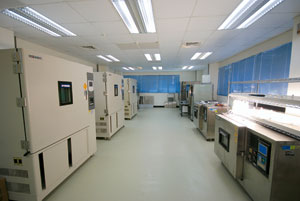Taiwan's LED Lighting Sector Needs More Than Standards to Glow Brighter
2009/06/05 | By Ken LiuWith the LED industrial chain in Taiwan having developed to considerable scale and sophistication, and the government working on a plan to replace traditional lamps with LED ones in four years islandwide, the time has come for Taiwan to set up quality inspection standards for LED lighting products.
Representatives from the government, LED industry and R&D institutes on the island recently gathered to flesh out the contents of a certification standard for LED lighting. One of the representatives was S.C. Wang, deputy director of Bureau of Standards, Metrology and Inspection (BSMI) under the Ministry of Economic Affairs. He noted that LED is a new lighting technology and needs certification standards to make it a popular light source. "BSMI has been working very hard to push for the establishment of certification systems. So far, we've imposed inspections on 34 LED products including 26 indicators, seven outdoor signages, four traffic lighting systems, 15 electronic components, and eight lighting products," Wang said.
Wang stressed that the bureau's safety inspection standards are mature relative to those for product functionality. The deputy director pointed out that his bureau has been studying international standards as reference to develop Taiwan's counterparts, and the government-backed Industrial Technology Research Institute (ITRI) and the ministry's Department of Industrial Technology have been drafting such standards. "Nevertheless, it usually takes R&D, field tests, time and various resources to turn certification drafts into law," Wang stressed.
Wang hopes to see all the government agencies draft LED certification standards annually as R&D projects backed by government incentives. "These drafts would be eventually ratified as national standards that meet manufacturers' needs after being reviewed and discussed by government and academic organizations," he said.
The CNS15233, an official inspection standard for LED streetlights publicized last year in Taiwan, is a good model for other LED-lighting standards, Wang said. Various other standards are being ratified, he added. "Now, we are working with the Department of Industrial Technology on nine more inspection standards to broaden its scope," Wang noted.

Inspected and Labeled
To help the island's LED lighting-fixture manufacturers effectively bid for public works projects, the government, Wang said, is inviting qualified private and public laboratories to inspect fixtures, which are labeled accordingly upon approval.
James Chu, Director of the Opto-Electronics Device and System Application Division of ITRI's Electronics and Optoelectronics Research Laboratories, pointed out that as Taiwan aims to foster LED lighting and solar energy into pivotal industries of the 21st century, the nation has to establish standards for industries to follow.
The Taiwan government, Chu said, has completed five of the 17 LED-lighting standards it had drafted in 2007. "Setting up standards for LED lighting is being undertaken by governments globally. Taiwan can set a good example with the considerable number of the standards it has completed," Chu boasted.
Proper Testing is Critical
Chu stressed that proper inspection of LED lamps is indispensable to ensure consumers can buy good quality products. "Compromised standards caused by excessive competition can be corrected by an official inspection organization. I understand that the government has included LED and photovoltaic manufacturing in its energy-industry policy, a positive development for Taiwan's LED industry," Chu added.
Chu suggested the government should work on an LED inspection system that covers a wide range of criteria: "For instance, the system should regulate not only LED light output efficacy, but also lifespan of lamp and components," he said.
The relatively low power bill in Taiwan ironically works against the development of the island's LED lighting market as such lamps are still expensive; so Chu suggested the government should subsidize the industry or offer incentives to manufacturers to enable them to reduce prices.
Chin-huai Yang, associate professor of the Department of Materials Technology and Department of Construction Engineering at the National Taiwan University of Science and Technology, advised the government to set up a quality-label system for the LED lighting industry as it did for the island's building-materials industry.
"Consumers equate quality building materials in Taiwan with the quality label," Yang said.
Officially-approved Label
Yang suggested the government label LED lighting products as officially-approved energy-saving products, and instruct an organization to focus on the establishment of relevant inspection standards.
However, setting up certification standards for the LED lighting in Taiwan may be merely an academic exercise given that a substantial number of the makers on the island are treading water in the wake of the global downturn. "To stimulate the development of the domestic LED-lighting industry, the government should subsidize consumers as it has done for solar-energy and energy-saving products," Yang noted.
Y.C. Chen, R&D vice president of Bright LED Electronics Corp., believes the government can prevent the island's LED-lighting industry from going under by addressing subsidization and inspection standards simultaneously. "Subsidies should not go to R&D, but directly to encouraging sales: subsidizing makers 30% of retail prices would help to quickly popularize LED lamps," he emphasized.
Subsidy as Lifesaver
Chen noted that any official subsidies for R&D projects offered to LED-lighting manufacturers may be too idealistic-taking too long to build products ready for laboratories-which is ineffective to stop makers from sinking deeper into the red. "Around one-fifth of Taiwan's approximately 100 LED-lighting manufacturers have dropped out of the market since the second half of last year. I believe two-thirds of the remaining would be forced to do the same if the recession persists into the end of this year," he warned.
Chen suggested the Taiwan government should emulate China to boost the island's LED-lighting industry. The mainland authorities subsidize 30% of single, big-volume purchase of efficient lighting products and as much as 50% on such procurements in rural and urban areas. "With official subsidies to manufacturers for 30% of selling prices, they will be willing to sell products at lower prices," he noted, adding that only manufacturers passing inspections are allowed to receive subsidies.
Keith Wang, chairman of Huiya Lighting Technology Co., Ltd., worries that a market without certification standards would be flooded with sub-standard products, with an influx of imports to compete against home-made products for government projects.
Standardized Environment
"The next few years would see the LED lighting definitely become a trend; but consumers cannot tell good LED from bad without official certification standards. Coupled with the disorderly development of the LED sector in Taiwan, setting up a standardized environment becomes even more critical for the industry to be competitive internationally," he observed.
Wang is confident of Taiwan's LED lighting capability, saying the industry is peerless for the island has a well established supply chain, offering everything from chip-making, packaging, module assembly to lighting fixture finishing. "On the one hand the government must work out clear standards for domestic manufacturers to compete for official projects; on the other hand, the government also has to offer subsidies to make LED lamps more affordable," he suggested.
Y.J. Hsieh, vice president of Asian Populace Marketing Energy-Saving Technology Co., Ltd., urged the government to educate consumers on the merits of LED-lighting products, as well as offer subsidies. "Most consumers are ignorant of LED lightings' energy-efficiencies. Maybe the Taipower (Taiwan Power Co., Ltd.) should print the advantages of LED lamps on electrical bills to enlighten consumers," she said.
To offset the higher cost of LED lamps, Hsieh suggested the Taiwan government should emulate the Japanese to subsidize buying LED lighting products. "As such I believe consumers would be more willing to replace traditional lamps with LED lamps. In addition, government organizations should take the lead to use energy-saving, durable lamps," she said.

Informed Consumers
Setting up certification standards, Hsieh suggested, should be prioritized over subsidization and consumer education so that "consumers can be informed buyers." "The government should tap the experience of other countries to develop domestic standards," she added.
President of LumiTesting Electronics Corp., J.C. Lin, echoed the importance of subsidizing the island's LED-lighting industry. "The American power company Consolidated Edison Inc. subsidizes customers for using LED lamps. Canadians can receive tax rebates for using energy-saving products. The Taiwan government should do the same to build its LED-lighting industry," he suggested.
Lin expressed his optimism towards the market outlook for LED lighting despite the global recession. "LumiTesting's brisk business is sign that the LED market is bright amid the gloomy economic downturn, while the slowdown gives more reason to use energy-efficient lighting," he noted.
Two-thirds Flickering
However, he emphasized that Taiwan's LED-lighting industry, after bold expansion, really needs government aid, especially with underselling competition among the manufacturers. "I foresee two-thirds of Taiwan's LED-lighting manufacturers to be phased out of the market without government help," he said.
C.S. Gou, president of Giantbright Technology Co., Ltd., is disappointed that the Taiwan government set up standards for LED streetlighting before working on standards for household LED lamps, as well as the lack of quality standards for the LED lighting industry.
Late last year, Taiwan unveiled the world's first standards for LED streetlights, which Gou believes would never be the prime driver to make LED lamps mainstream. "The hope to popularize LED lighting has to be pinned on household LED MR16 and LED daily lights. So, Taiwan should establish standards for such lights as soon as possible," he stressed.
"Even the mainland Chinese government is more aggressive than Taiwan to develop the LED-lighting industry," Gou said.
Taiwan's LED lighting market is in chaos without quality standards, Gou said. "The result is that manufacturers are in a free-for-all, with the reality that a 20-lumen-per-watt lamp being priced the same as a 50-lumen-per-watt lamp. It is really counterproductive and misleads consumers."




